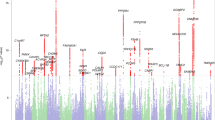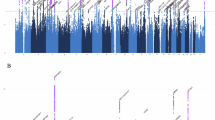Abstract
The 6p21-p22 chromosomal region has been identified as a developmental dyslexia locus both in linkage and association studies, the latter generating evidence for the doublecortin domain containing 2 (DCDC2) as a candidate gene at this locus (and also for KIAA0319). Here, we report an association between DCDC2 and reading and spelling ability in 522 families of adolescent twins unselected for reading impairment. Family-based association was conducted on 21 single nucleotide polymorphisms (SNPs) in DCDC2 using quantitative measures of lexical processing (irregular-word reading), phonological decoding (non-word reading) and spelling-based measures of dyslexia derived from the Components of Reading Examination test. Significant support for association was found for rs1419228 with regular-word reading and spelling (P=0.002) as well as irregular-word reading (P=0.004), whereas rs1091047 was significantly associated (P=0.003) with irregular-word reading (a measure of lexical storage). Four additional SNPs (rs9467075, rs9467076, rs7765678 and rs6922023) were nominally associated with reading and spelling. This study provides support for DCDC2 as a risk gene for reading disorder, and suggests that this risk factor acts on normally varying reading skill in the general population.
Similar content being viewed by others
Log in or create a free account to read this content
Gain free access to this article, as well as selected content from this journal and more on nature.com
or
References
Shaywitz SE, Shaywitz BA : Dyslexia (specific reading disability). Biol Psychiatry 2005; 57: 1301–1309.
Shaywitz SE, Escobar MD, Shaywitz BA, Fletcher JM, Makuch R : Evidence that dyslexia may represent the lower tail of a normal distribution of reading ability. N Engl J Med 1992; 326: 145–150.
Bates TC, Castles A, Luciano M, Wright MJ, Coltheart M, Martin NG : Genetic and environmental bases of reading and spelling: a unified genetic dual route model. Read Writ 2007; 20: 147–171.
Bates TC, Luciano M, Castles A, Coltheart M, Wright MJ, Martin NG : Replication of reported linkages for dyslexia and spelling and suggestive evidence for novel regions on chromosomes 4 and 17. Eur J Hum Genet 2007; 15: 194–203.
Williams J, O’Donovan MC : The genetics of developmental dyslexia. Eur J Hum Genet 2006; 14: 681–689.
Cardon LR, Smith SD, Fulker DW, Kimberling WJ, Pennington BF, DeFries JC : Quantitative trait locus for reading disability on chromosome 6. Science 1994; 266: 276–279.
Harold D, Paracchini S, Scerri T et al: Further evidence that the KIAA0319 gene confers susceptibility to developmental dyslexia. Mol Psychiatry 2006; 11: 1085–1091, 1061.
Deffenbacher KE, Kenyon JB, Hoover DM et al: Refinement of the 6p21.3 quantitative trait locus influencing dyslexia: linkage and association analyses. Hum Genet 2004; 115: 128–138.
Meng H, Smith SD, Hager K et al: DCDC2 is associated with reading disability and modulates neuronal development in the brain. Proc Natl Acad Sci USA 2005; 102: 17053–17058.
Schumacher J, Anthoni H, Dahdouh F et al: Strong genetic evidence of DCDC2 as a susceptibility gene for dyslexia. Am J Hum Genet 2006; 78: 52–62.
Brkanac Z, Chapman NH, Matsushita MM et al: Evaluation of candidate genes for DYX1 and DYX2 in families with dyslexia. Am J Med Genet B Neuropsychiatr Genet 2007; 144: 556–560.
Couto JM, Livne-Bar I, Huang K et al: Association of reading disabilities with regions marked by acetylated H3 histones in KIAA0319. Am J Med Genet B Neuropsychiatr Genet 2009, e-pub ahead of print 8 July 2009.
Galaburda AM, Sherman GF, Rosen GD, Aboitiz F, Geschwind N : Developmental dyslexia: four consecutive patients with cortical anomalies. Ann Neurol 1985; 18: 222–233.
Gleeson JG, Lin PT, Flanagan LA, Walsh CA : Doublecortin is a microtubule-associated protein and is expressed widely by migrating neurons. Neuron 1999; 23: 257–271.
Ludwig KU, Schumacher J, Schulte-Korne G et al: Investigation of the DCDC2 intron 2 deletion/compound short tandem repeat polymorphism in a large German dyslexia sample. Psychiatr Genet 2008; 18: 310–312.
Meda SA, Gelernter J, Gruen JR et al: Polymorphism of DCDC2 reveals differences in cortical morphology of healthy individuals-a preliminary voxel based morphometry study. Brain Imaging Behav 2008; 2: 21–26.
Bates TC, Castles A, Coltheart M, Gillespie N, Wright MJ, Martin NG : Behaviour genetic analyses of reading and spelling: a component processes approach. Aust J Psychol 2004; 56: 115–126.
Zhu G, Duffy DL, Eldridge A et al: A major quantitative-trait locus for mole density is linked to the familial melanoma gene CDKN2A: a maximum-likelihood combined linkage and association analysis in twins and their sibs. Am J Hum Genet 1999; 65: 483–492.
Wright MJ, Martin NG : Brisbane Adolescent Twin Study: outline of study methods and research projects. Aust J Psychol 2004; 56: 65–78.
Luciano M, Wright MJ, Geffen GM, Geffen LB, Smith GA, Martin NG : A genetic investigation of the covariation among inspection time, choice reaction time, and IQ subtest scores. Behav Genet 2004; 34: 41–50.
Nyholt DR : On the probability of dizygotic twins being concordant for two alleles at multiple polymorphic loci. Twin Res Hum Genet 2006; 9: 194–197.
Castles A, Coltheart M : Varieties of developmental dyslexia. Cognition 1993; 47: 149–180.
Martin NW, Hansell NK, Wainwright MA et al: Genetic covariation between the Author Recognition Test and reading and verbal abilities: what can we learn from the analysis of high performance? Behav Genet 2009; 39: 417–426.
Marlow AJ, Fisher SE, Richardson AJ et al: Investigation of quantitative measures related to reading disability in a large sample of sib-pairs from the UK. Behav Genet 2001; 31: 219–230.
Jackson DN : Manual for the Multidimensional Aptitude Battery. Port Huron, MI: Research Psychologists Press, 1984.
Luciano M, Lind PA, Duffy DL et al: A haplotype spanning KIAA0319 and TTRAP is associated with normal variation in reading and spelling ability. Biol Psychiatry 2007; 62: 811–817.
The International HapMap Consortium: The International HapMap Project. Nature 2003; 426: 789–796.
Barrett JC, Fry B, Maller J, Daly MJ : Haploview: analysis and visualization of LD and haplotype maps. Bioinformatics 2005; 21: 263–265.
Wigginton JE, Abecasis GR : PEDSTATS: descriptive statistics, graphics and quality assessment for gene mapping data. Bioinformatics 2005; 21: 3445–3447.
Abecasis GR, Cherny SS, Cookson WO, Cardon LR : Merlin – rapid analysis of dense genetic maps using sparse gene flow trees. Nat Genet 2002; 30: 97–101.
Abecasis GR, Cardon LR, Cookson WO : A general test of association for quantitative traits in nuclear families. Am J Hum Genet 2000; 66: 279–292.
Nyholt DR : A simple correction for multiple testing for single-nucleotide polymorphisms in linkage disequilibrium with each other. Am J Hum Genet 2004; 74: 765–769.
Purcell S, Cherny SS, Sham PC : Genetic Power Calculator: design of linkage and association genetic mapping studies of complex traits. Bioinformatics 2003; 19: 149–150.
Gabriel SB, Schaffner SF, Nguyen H et al: The structure of haplotype blocks in the human genome. Science 2002; 296: 2225–2229.
Nyholt DR : ssSNPer: identifying statistically similar SNPs to aid interpretation of genetic association studies. Bioinformatics 2006; 22: 2960–2961.
Couto JM, Gomez L, Wigg K et al: Association of attention-deficit/hyperactivity disorder with a candidate region for reading disabilities on chromosome 6p. Biol Psychiatry 2009; 66: 368–375.
Wilcke A, Weissfuss J, Kirsten H, Wolfram G, Boltze J, Ahnert P : The role of gene DCDC2 in German dyslexics. Ann Dyslexia 2009; 59: 1–11.
Kaplan DE, Gayan J, Ahn J et al: Evidence for linkage and association with reading disability on 6p21.3-22. Am J Hum Genet 2002; 70: 1287–1298.
Marlow AJ, Fisher SE, Francks C et al: Use of multivariate linkage analysis for dissection of a complex cognitive trait. Am J Hum Genet 2003; 72: 561–570.
Gleeson JG, Allen KM, Fox JW et al: Doublecortin, a brain-specific gene mutated in human X-linked lissencephaly and double cortex syndrome, encodes a putative signaling protein. Cell 1998; 92: 63–72.
Rosen GD, Bai J, Wang Y et al: Disruption of neuronal migration by RNAi of Dyx1c1 results in neocortical and hippocampal malformations. Cereb Cortex 2007; 17: 2562–2572.
Burbridge TJ, Wang Y, Volz AJ et al: Postnatal analysis of the effect of embryonic knockdown and overexpression of candidate dyslexia susceptibility gene homolog Dcdc2 in the rat. Neuroscience 2008; 152: 723–733.
Galaburda AM, LoTurco J, Ramus F, Fitch RH, Rosen GD : From genes to behavior in developmental dyslexia. Nat Neurosci 2006; 9: 1213–1217.
Paracchini S, Thomas A, Castro S et al: The chromosome 6p22 haplotype associated with dyslexia reduces the expression of KIAA0319, a novel gene involved in neuronal migration. Hum Mol Genet 2006; 15: 1659–1666.
Acknowledgements
We thank the twins and their parents for their cooperation; Anjali Henders and Megan Campbell for managing sample processing and DNA extraction; Alison Mackenzie and Thanuja Gunasekera for coordinating the reading test battery mail-out; and the many research interviewers for data collection. This research was supported by the Scottish Chief Scientists Office (TCB) and the Australian Research Council (#: A79600334, A79906588, A79801419, DP0212016 and DP0343921). ML was supported by an Australian Research Council Postdoctoral Fellowship (grant # DP0449598).
Author information
Authors and Affiliations
Corresponding author
Ethics declarations
Competing interests
The authors declare no conflict of interest.
Additional information
Supplementary Information accompanies the paper on European Journal of Human Genetics website
Rights and permissions
About this article
Cite this article
Lind, P., Luciano, M., Wright, M. et al. Dyslexia and DCDC2: normal variation in reading and spelling is associated with DCDC2 polymorphisms in an Australian population sample. Eur J Hum Genet 18, 668–673 (2010). https://doi.org/10.1038/ejhg.2009.237
Received:
Revised:
Accepted:
Published:
Issue date:
DOI: https://doi.org/10.1038/ejhg.2009.237
Keywords
This article is cited by
-
Dyslexia-related loci are significantly associated with language and literacy in Chinese–English bilingual Hong Kong Chinese twins
Human Genetics (2023)
-
The Influence of Dyslexia Candidate Genes on Reading Skill in Old Age
Behavior Genetics (2018)
-
Neurogenetics of developmental dyslexia: from genes to behavior through brain neuroimaging and cognitive and sensorial mechanisms
Translational Psychiatry (2017)
-
Single Nucleotide Polymorphisms Associated with Reading Ability Show Connection to Socio-Economic Outcomes
Behavior Genetics (2017)
-
Association, characterisation and meta-analysis of SNPs linked to general reading ability in a German dyslexia case-control cohort
Scientific Reports (2016)



